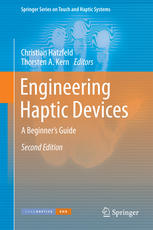

Most ebook files are in PDF format, so you can easily read them using various software such as Foxit Reader or directly on the Google Chrome browser.
Some ebook files are released by publishers in other formats such as .awz, .mobi, .epub, .fb2, etc. You may need to install specific software to read these formats on mobile/PC, such as Calibre.
Please read the tutorial at this link: https://ebookbell.com/faq
We offer FREE conversion to the popular formats you request; however, this may take some time. Therefore, right after payment, please email us, and we will try to provide the service as quickly as possible.
For some exceptional file formats or broken links (if any), please refrain from opening any disputes. Instead, email us first, and we will try to assist within a maximum of 6 hours.
EbookBell Team

5.0
80 reviewsIn this greatly reworked second edition of Engineering Haptic Devices the psychophysic content has been thoroughly revised and updated. Chapters on haptic interaction, system structures and design methodology were rewritten from scratch to include further basic principles and recent findings. New chapters on the evaluation of haptic systems and the design of three exemplary haptic systems from science and industry have been added.
This book was written for students and engineers that are faced with the development of a task-specific haptic system. It is a reference book for the basics of haptic interaction and existing haptic systems and methods as well as an excellent source of information for technical questions arising in the design process of systems and components.
Divided into two parts, part 1 contains typical application areas of haptic systems and a thorough analysis of haptics as an interaction modality. The role of the user in the design of haptic systems is discussed and relevant design and development stages are outlined. Part II presents all relevant problems in the design of haptic systems including general system and control structures, kinematic structures, actuator principles and sensors for force and kinematic measures. Further chapters examine interfaces and software development for virtual reality simulations.